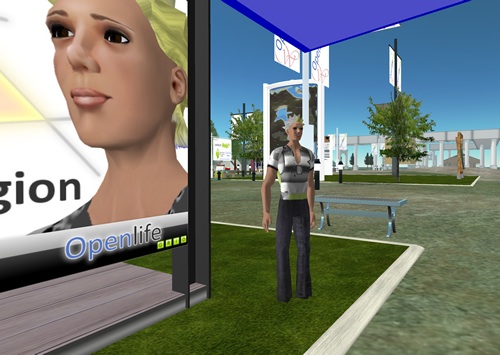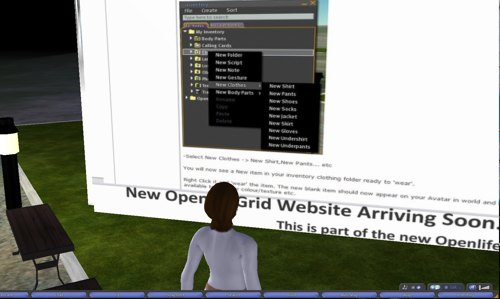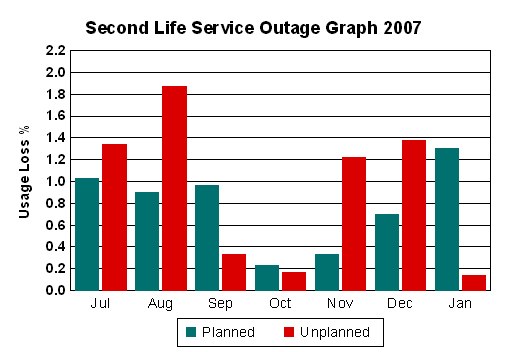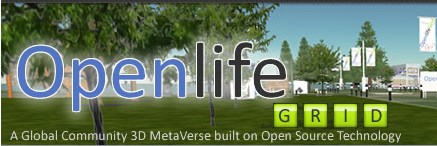Al the details here. Do have a good read of the specific system requirements, as your PC’s video card may still be the primary cause of any issues.
Archives for February 2008
A year ago on The Metaverse Journal
We interviewed Logan Linden AKA Australian Chris Collins on his work with Linden Lab.
Interview – Sakai Openlife (Openlife founder)
As we reported earlier this week, Openlife is a promising new alternative grid to Second Life. Its founder, Sakai Openlife (RL: Steve Sima) is based in Brisbane and we caught up with him via Openlife’s Live Chat for a discussion on everything Openlife.

Lowell: Sakai – Openlife came out of the blue for me but it’s obviously been a labour of love for you – can you give a potted history of how Openlife came to be?
Sakai: Sure, we kicked things off approximately four months ago and clearly had to do a lot of work to understand a workable solid method to approach it. Number one has always been and will be the Users. So with this in mind it has been quite a colourful ride trying to foster the community together and maintain the best user experience we can with the code available.
Lowell: what made you start this huge undertaking?
Sakai: Well, I’ve had a passion for 3D interactive platforms for ages and my background is IT infrastructure. So to provide a solid platform being feature rich and extensive for different uses is most certainly up my alley. After following the OpenSimulator project for a while I took the decision to make the plunge and start treading the water with the OpenSim Application Platform – Second Life had some big drawbacks for me.
Lowell: I’m assuming you’ve used Second Life extensively prior to this project? What was it about Second Life in particular that you wanted to improve on?
Sakai: Some towards content creation and development of content and some towards the user experience. Second Life itself I see has been hugely popular with its social interaction and it’s a great environment to see this in action. They have been pioneers in this area for years but to have an open source platform where as a company you could develop very feature rich immersive environments and provide them to users is something that Second Life falls short on in my opinion, but the potential for this to happen with the Openlife Grid & OpenSimulator Codebase is very much a possibility.
Lowell: What areas do you specifically see Openlife having advantages in?
Sakai: One thing we are keen to see in the near future is the ability to content create and develop a region on your local environment ie. home PC or workplace network then export that entirely to a published region existing in the Openlife Grid.
Lowell: So, fully offline region-wide content creation?
Sakai: Correct, exciting isn’t it. This can bring in the quality of in-world environments to a whole new level.
Lowell: I can see that would get a lot of people excited – is that option close?
Sakai: Yes it is close, currently we can take the terrain and prims created. Clearly there are other things to bring over such as textures, scripts etc.
Lowell: So for the sake of the potential new user – is Openlife in beta at present or a fully functioning option?
Sakai: No it is not a fully functioning option at the moment. We work closely with, and implement the Opensimulator source code which in itself is only recently version 0.5. However, community interaction and involvement in the Openlife Grid is important as the code moves forward.
Lowell: So is there a roadmap and/or timeline for OpenSimulator and subsequently a fully functional Openlife?
Sakai: With the source code being a community project ‘exact’ timelines can be difficult to adhere to. However, the OpenlifeGrid is at the tip of releasing the Foundation Resident Event, enabling Openlife users to have their own region in-world. The other side of this is that it will help full-time developers to work on the code on a professional level. Naturally, this work is in conjunction with the OpenSimulator effort and is released back to the community.
Lowell: So in regard to Openlife specifically – how many are involved in its development?
Sakai: We currently have two people including myself, but receive invaluable contributions from the Openlife community, making the Openlife Grid very much a community effort.

Lowell: And can you tell me a little about yourself? You’re based in Brisbane?
Sakai: Yes, sunny (but raining a lot lately) Brisvegas. I have a strong history of IT, and a passion for pioneering new technologies.
LLowell: Do you run your own business or are you from the academic side of the IT fence?
Sakai: I do run my own company. But it should be mentioned in regard to the Openlife Grid that there is some university involvement and it’s very much welcomed.
Lowell: Are you able to discuss which universities are involved?
Sakai: Hmm, good Question. I think it may be best that we give them the opportunity to express any involvement through the site, and their own sites.
Lowell: On interoperability – Linden Lab’s release of the SL code has helped get things where they are today but do you have any ongoing communication with Linden Lab in regard to your work?
Sakai: Personally I have only recently had some conversations with Linden Labs at a Finland event in relation to the Openlife Grid. But we are not ‘Anti-Linden’
Lowell: And were they receptive to the work you’re doing?
Sakai: Yes, I believe Linden labs has been fairly receptive of the Openlife Grid and also the OpenSimulator Project. There are even Lindens in the Openlife Grid as
users.
Lowell: So what are your plans over the coming weeks? I’m assuming more sleep isn’t part of it.
Sakai: Wow, sleep I almost forgot that thing. Since we started we have steadily grown to around 6000 users as at a week ago. I’ve been working on this new website which is still being implemented (but online) with the aim to foster and grow the community. But in the weekend past we saw the number of users jump to (as of a few hours ago) 10,000 users.
Lowell: So as of now, what can a new user do in Openlife?
Sakai: Hmm… really it’s a very free environment limited only by the features of the current code level. But there are the natural ones similar to Second Life -meeting new people, making friends, getting involved with Openlife Communities. Building your own creations, and as of tommorrow owning your own regions.
Lowell: So people can log in now and intereact as they would in SL?
Sakai: Correct. You can login with the existing Second Life viewer and interact very much the same as Second Life, with the only limitations being the features that exist in the current code level.
Lowell: Ahhh ok, that was my next question. So there’s no need to download a different viewer?
Sakai: A different viewer is not necessary just a change to the shortcut or you can use a little program on our website to redirect your viewer to the Openlife grid. However, on an exciting note, an alternative viewer will be available very soon. That is in development by the RealXtend team.
Lowell: So if you had to sum up in a sentence or two why people should sign up to the Openlife community, what would you say?
Sakai: Wow, it’s really hard to sum up so short with such a wide community involved. Joining the Openlife Grid community is a chance to be involved in a pioneering new platform where your suggestions and ideas are very welcome, your feedback is important, and your participation is valued. Currently we are playing catch up to the number of new users, however since you can decide your own name, if you are a current SL user it’s a good idea to at least register to follow the news and secure your Second Life name in the Openlife Grid.
Lowell: Most people will want some key aspect to convince them to make the effort to experiment with a new platform – do you see superior community support as that key aspect?
Sakai: Absolutely – a lot of work has been going into the new site, to bring communities together including blogs for community regions, live online chat rooms for when you can’t be in world (like at work – ooops!). Foundation Residents have regions in-world and they also recieve a blog for their region to help bring the users together. Whilst blogs are not everything, there are also ‘Community Regions’ in-world. These are free to participate in and are provided free to the community.
Lowell: Is Openlife looking for venture capital in the future?
Sakai: The Openlife Grid is new territory and clearly funding would accelerate the efforts, however it must be noted we would not take on funding at the expense of the user or the future goals of the Openlifegrid. So in short it’s welcome if the funding can match the desires of the community.
Lowell: Do you have a proposed pricing structure for users when Openlife is fully functional?
Sakai: At this time we do not. It is important to note there are key differentiators between the way the Openlife works and Second Life. Linden Lab provides all the land (servers) and so has a monopoly on land (resources) to an effect.

Lowell: Whereas people can supply their own servers in Openlife?
Sakai: Openlife is moving towards a ‘provider’ path where ISPs and Web Hosts would also be able to provide resources. So as a user or company, having your own presence or land in-world could be purchased from many providers, reducing the cost and keeping it affordable for all.
Lowell: I’m assuming users could purchase land from you if they don’t want to provide their own server?
Sakai: Currently we don’t support external user connections, as we have stability and security to be concerned with in order to bring the best user experience.
The Foundation Resident is the first opportunity for Openlife residents to own a region in-world.
Lowell: So to clarify – people will eventually be able to host their own region or buy a region from Openlife
Sakai: Eventually that is one of the aims. But it will be gradual process as the code develops. The Foundation Resident is only a limited release of regions. They have no ‘purchase’ price, only a monthly fee. When we reach the limit of the Foundation Resident regions we will evaluate the next steps.
Lowell: Well I think that pretty well sums it up Sakai – thanks for taking the time.
For instructions on connecting to Openlife using your Second Life viewer, go here.
Latest Second Life service metrics posted
It’s all here on the Linden blog. There’s now a full set of data for 2007 performance including until end of January 2008:

It’s fair to say things are still far from pretty on the stability side. Still more than one in five Second Life sessions end in either a viewer or region crash although there’s been a marginal improvement in frame-rates.
How’s your stability been in recent weeks?
The Watch – virtual worlds in the news
1. The Washington Post – Spies’ Battleground Turns Virtual. “U.S. intelligence officials are cautioning that popular Internet services that enable computer users to adopt cartoon-like personas in three-dimensional online spaces also are creating security vulnerabilities by opening novel ways for terrorists and criminals to move money, organize and conduct corporate espionage”.
2. CNN Money – Pointing The Way To New Web Worlds. “You can sling from one Web to another in business these days. The so-called Web 2.0 technologies that gave birth to consumer blogs, social networks and other ways to offer product advice are weaving their way into the corporate world”.
3. CNET – Teen virtual world goes Hollywood. “Habbo, a virtual world for teens, signed a deal with the William Morris Agency, one of Hollywood’s oldest and largest talent agencies. As part of the deal, WMA will promote its celebrity sports and entertainment clients within the digital world and help Habbo forge new promotional partnerships in Hollywood”.
4. ClickZ – MinyanLand Virtual World Aims to Teach Kids Finance. “Teaching kids financial responsibility can be fun and advertisers should come along for the ride, say the creators of MinyanLand, a virtual world for kids. Launched January 30, MinyanLand is the result of the National Council on Economic Education, financial infotainment company Minyanville and family site network Kaboose, coming together to try and educate children in grades three to six about the importance of financial responsibility and thrifty spending. Unlike several other virtual worlds targeting the kids market, including Disney’s Club Penguin, Minyanland does not require a subscription fee to participate, according to Kevin Wassong, president of Minyanville”.
5. ABC Science (Australia) – Bionic lens spies virtual world. “Engineers say they have combined a flexible contact lens with an imprinted electronic circuit and lights for the first time. The ‘bionic’ lens could give wearers a new look at the world by superimposing computerised images onto their natural view. Such virtual displays could be useful to drivers and pilots, who could have route, weather or vehicle status information overlaid onto their vision. Video game players could immerse themselves in a virtual world without restricting their range of motion”.
6. CNN – For online addicts, relationships float between real, virtual worlds. “Think of online video game addiction and what probably comes to mind is a socially awkward adolescent. But teens are not the only ones who get addicted. Consider Zach Elliott, who lives in the U.S. state of Wisconsin, is in his mid-40s, and plays Final Fantasy XI, an online role-playing game. About three years ago, he says, “there were people in my real life that sort of vanished into this game, and I followed them into it””.
7. FOX Business – Multiverse Unveils Virtual Times Square. “The Multiverse Network, Inc., the company building the leading network of 3D virtual worlds, today unveiled Virtual Times Square, a true-to-life digital recreation of one of the world’s most famous metropolitan environments”.
8. CIO.com – Companies Explore Virtual Worlds As Collaboration Tools. “For emergency responders working along Interstate 95, accidents aren’t a game; they’re a way of life (and death). So it seemed odd to a group of firefighters, cops and medics when researchers from the University of Maryland suggested it use a virtual world to collaborate on training for rollovers, multicar pileups and life-threatening injuries”.
9. TrainingZone.co.uk – View to a Kill: Training in Virtual Worlds. “Learning and training are likely to be the ‘killer application’ for computer-generated 3D worlds such as Second Life, delegates heard at the Learning Technologies event in London last week. Capgemini consultant Marco Tippmer made the claim during a session on the hype and realities of the latest training technology. We have been here before, he admitted, during the ‘virtual reality 1.0’ bust in the early 1990s, when lack of sufficient computing power undermined expectations surrounding touch-sensitive gloves and immersive 3D headsets”.
10. ZDNet UK – Nortel: Virtual worlds may replace the office. “Nortel Networks is looking to the next generation of employees to shape the workplace of tomorrow, and high on its agenda is exploring the role of Web 2.0 technologies and virtual worlds such as Linden Lab’s Second Life”.
Openlife – Second Life’s open source competitor
Openlife is the first fourth alternative Second Life grid to open up for widespread access.
It’s still a work in progress but one that’s well worth exploring, something I’ll be doing in coming days and weeks.

Openlife’s creator, Sakai Openlife, is based in Australia and we’ve made contact with him for an interview – stay tuned for further details.
Thanks to Tateru Nino at Massively and SL Universe for the heads-up.
Update: A further thanks to Tateru Nino for pointing out that Openlife is actually the fourth alternative grid – there’s also Central Grid, OS Grid and Deep Grid.
Will virtual worlds get a guernsey at Rudd’s summit?
In recent weeks there’s been significant coverage of Prime Minister Kevin Rudd’s summit (two examples here and here). Some commentators see it as an opportunity to get some ideas on the table bt it’s fair to say most see it as a talk-fest unlikely to generate any lasting policy initiatives. I wouldn’t be quite as cynical as that, but I have my doubts on how much can be achieved with a thousand people in a room for two days. The ego quotient alone will pose a challenge.
Given the focus is Australia’s future in 2020 you’d hope there’s at least a studied mention of the impact virtual worlds are likely to have in the future. The potential downsides of heavy virtual world use on its own should draw some interest let alone all the great opportunities to be had in the virtual sphere that could benefit Australia in coming years. Some of the more obvious challenges for government in regard to virtual worlds include:
1. Australia’s lagging broadband infrastructure;
2. Consumer protection in virtual world transactions;
3. Clarity on taxation and financial regulation;
4. Appropriately trained addiction and counselling services;
5. Expansion of research and development funding for business, non-profit, education and health in the virtual world sphere.
Who would you like to send to the summit to wave the flag? What questions / issues would you like to see raised?
(I’ve already declined an invitation – I’m washing my hair that night ).
The Linden Department of Public Works launches
Linden Lab today announced some long overdue content creation for mainland residents of Second Life:
“What will we work on? Good question; basically, we will consider anything and everything that we feel will make the mainland more attractive, fun, engaging and interesting for new or existing residents. Initially, we’re looking at extending the city area which is very popular, so that will involve some new built up areas to the west of Barcola (joined via bridges to preserve existing water views). We’ll also be looking at new park areas, Linden folly builds, beautifying existing Linden land, better gathering places and seeding new mainland with themed builds. Some of the content may find its way into the Library in your inventories.”
I doubt anyone will decry this initiative – anything that’s created to offset the proliferation of 16m2 advertisement plots will be extremely welcome.
Update: Linden Lab are inviting applications from Second Life builders.
Weekend Whimsy
1. Knowville 3D in Second Life
2. Sexy Furs Dancing
3. A Night Elf’s Dream
Recent Comments